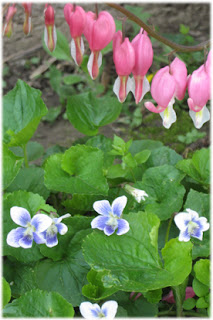I just love to get down and get personal when I weed my plants. I seem to be communing with Nature and each of the plants. I guess you'd say we have a 1 to 1 relationship. I simply love them. And they teach me a lot.
And what did I learn this day? One of my favorite things to do is to learn what baby seedlings look like. Sometimes they don't look anything like mature plants. They are tiny but, if they are herbs, they are already aromatic. We have lots of Mother Plants. Lifting their leaves gently, I noted tiny Babies scattered beneath Violets, Oregano, Lemon Balm. Lots of them. All are perennials. Of course last year's annuals are long gone. I noted baby Lettuce Plants (which are annuals) were most likely to be found nestled around other plants. They were south of where the original plants were. That must be because the Seeds found shelter from winter's northerly winds.
Violets are doing well. All the Native plants are. This is their home. This Violet is a variety native to this area. We got it by accident from Richard's Mother when she sent Irises and Live Forever up for our new house and garden in the late 1970s. She got it from Hollis. And we brought it back with us when we moved here 4 years ago.
The Bleeding Heart is blooming in profusion. I think this is its best year yet. I don't see any Seedlings around the Mother Plant, yet.
As I was weeding, I noticed that roots of Weeds hold tenaciously to Soil. That's their job. They are the 1st line of defense in protecting Soil from leaving and in reclaiming its health and vitality. What Plants will I find that will do that job?
The Verbena, which is a Native Plant, is doing very well in the west Garden. It is a ground cover and it is spreading. I think I will tuck some pieces of it around the West Gardens. It should protect the Soil. Plus, designwise, it will make a great plant for "continuity". And it blooms from spring through fall.
I potted up Catnip, Chives, and Garlic. I added them to the Echinacea, which is in a sheltered area on the north side of the house. These plants will be for the Seed and Plant Exchange. Other plants are waiting eagerly in cue to be potted up too. I learned I love to give plants away too. But I knew that already. I guess I just learned it more.






















